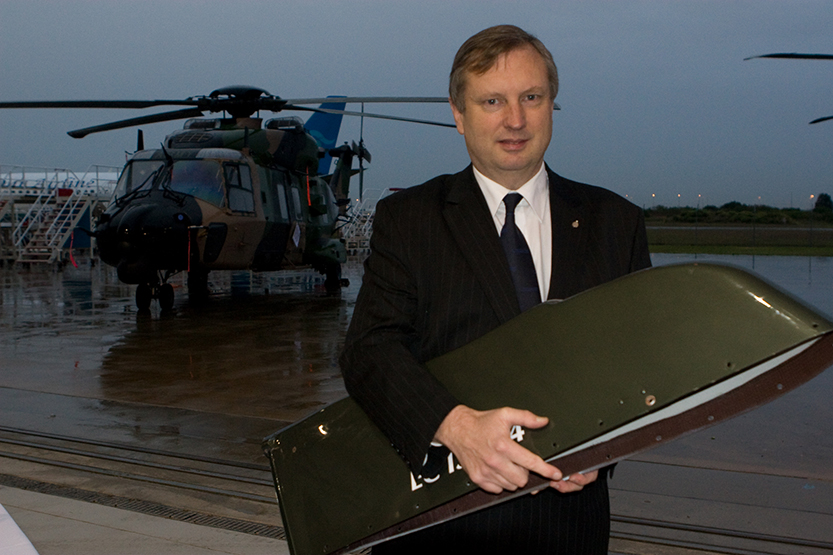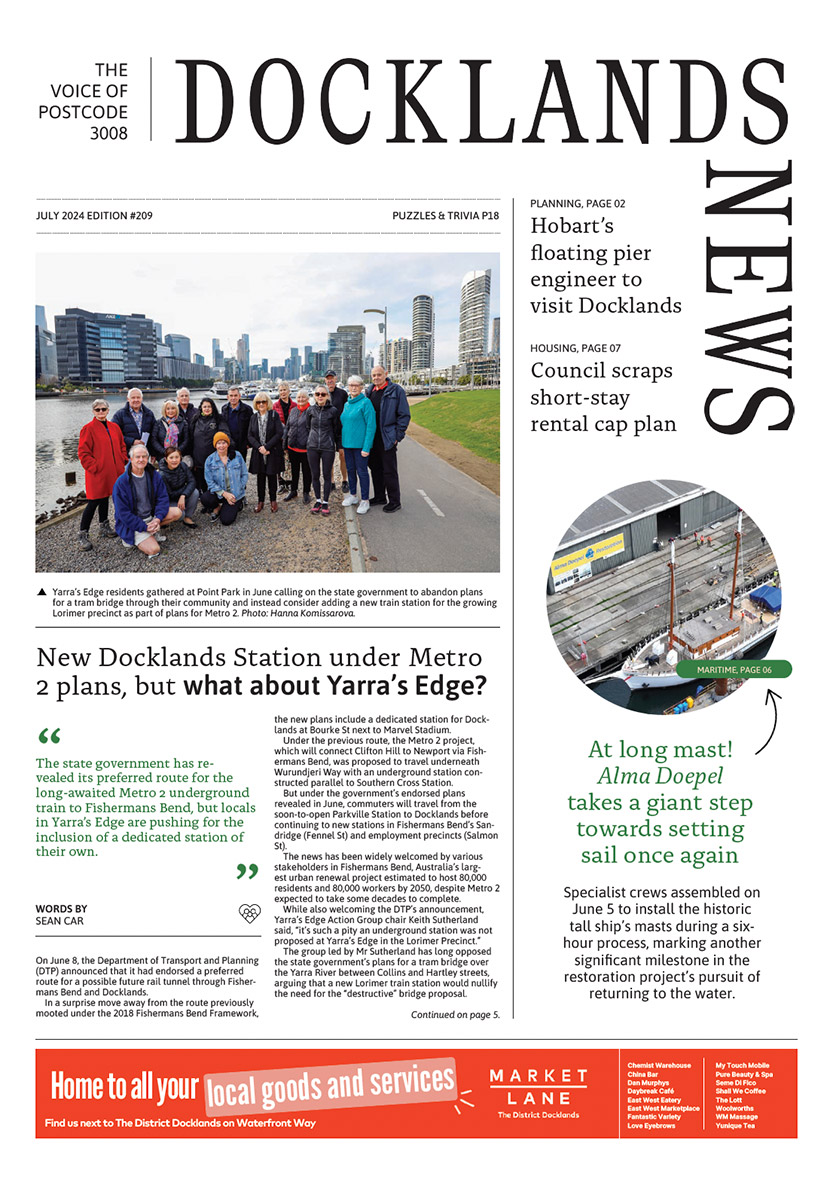From hypersonic vehicles to dinosaur jaws: 30 years of making advanced composites in Fishermans Bend
You’d be hard pressed to find anyone with more lived experience working in Fishermans Bend than chairman of Advanced Composite Structures Australia (ACS-A) Professor Murray Scott.
In a career spanning more than 45 years, which all began back in 1977 at 304 Lorimer St with what was the Commonwealth Aircraft Corporation, then Hawker de Havilland and finally Boeing Aerostructures Australia (BAA), now at 226 Lorimer St, the decorated aerospace engineer in many ways embodies the proud history of innovation in Fishermans Bend.
With ACS-A today based at 198 Lorimer St – one of three locations it has operated in along the street during its 31-year history – Prof. Scott is very familiar with the area’s “incredible aerospace heritage” and the “great foundation” it provides current government planning efforts to build on.
In reflecting on his journey in Fishermans Bend, he said, “I do remember at the time [1977] wondering how much of my professional career might be spent down there, and it’s turned out to be pretty much all of it”.
“The fact is that when people drive along the roads in Fishermans Bend, they wouldn’t know that some of those same spaces were once runways or aircraft factories,” he said.
“Interestingly, there’s still some remnants of facilities that people wouldn’t even know were part of, for example, the Commonwealth Aircraft Corporation … but I know! I used to go in those buildings.”
“So, it’s all there – the past and the future – it [Fishermans Bend] couldn’t be in a better location.”
And, since those early days, Prof. Scott has gone on to make many major contributions to the field of aerospace engineering, playing a key role in adding to its rich history across industry and academia both here in Australia, and overseas.
Today, he continues his unwavering dedication as chair of the Joint Board for Aerospace Engineering of Engineers Australia and the Royal Aeronautical Society, a committee member of the International Council of the Aeronautical Sciences, and as an Adjunct Professor in the School of Engineering at RMIT University.
And, of course, in his role as chairman of ACS-A, a company which last year celebrated 30 years working in research and development of advanced composites that all began with the establishment of what became the Cooperative Research Centre for Advanced Composite Structures (CRC-ACS).
While they’re words which might not immediately spell excitement to the average person, advanced composites are one of the crucial components anyone who has travelled in a Boeing 787 Dreamliner can thank for a safe flight.
After all, Prof. Scott said it was thanks to the “significant research and development contributions” of the ACS-A team and their many CRC-ACS collaborators that ultimately led to the “huge Australian success story” of the carbon fibre composites of which jet airliner wing trailing edge components are made from in Fishermans Bend.
“The Boeing 787 design and manufacturing activity at BAA had its genesis basically in the research that we did, and that’s all to do with efficient and cost-effective design and manufacture of aerospace components,” Prof. Scott said.
“People often take a lot of things for granted; a lot of advanced engineering goes unnoticed. But it’s very lightweight, and a very high safety standard is required for something like that.”
But while ACS-A is best known for its aerospace work, that’s just the tip of the iceberg when it comes to the application of composite materials in many other essential and fascinating use cases.

While a major part of its work supports the locally-based Defence organisations, it also collaborates with another well-known innovator in Fishermans Bend – Creature Technology – in engineering some of the composites for its animatronics, such as jaw plates for its giant dinosaurs.
Beyond that, ACS-A has engineered composites for a range of special use products and services, including renewable wave energy devices, hydroelectric turbines, jet packs, tankers, freight train ore wagons and various fire-resistant structures.
Looking ahead, Prof. Scott said the company was now investing in ultra-high temperature composites for application on hypersonic vehicles associated with use in space and at high altitudes.
“I think it’s really exciting,” he said. “This is something which Australia has not really had much engagement in for a very long time, and I say very long time because it’s associated with space and very fast vehicles flying through the atmosphere.”
“They get extremely hot, and you need a completely different class of composite material for that, so we’re investing in that infrastructure and working with another important Lorimer St organisation – the Defence Science and Technology Group.”
While many organisations might possess the in-house engineering skills capable of completing less technical jobs, Prof Scott said ASC-A came in when a client had particularly “unusual” or “special” requirements.
Working through each of these requirements hand-in-hand with the client from start to finish on design and engineering right through to simulation and testing, and in recent years, expanding its services to do “specialised, high-value manufacturing”, Prof Scott said the company was anything but a “build-to-print producer”.
“It all starts with engineering design and analysis, selecting the right fibres and matrix materials, and then simulating that,” he said. “So, we do a tremendous amount of advanced computer simulation of the design, the operation and, of course, the manufacturing processes necessary to get things right the first time.”
“Then that moves on to quite often physical testing of components right through to demonstrating the technology, building a prototype, doing certification testing and then delivering – that’s been our traditional business model.”
“But what’s new for us is that in the past few years, basically as a result of a customer requirement, they wanted us to actually continue with the serial manufacturing ourselves, and so we’re now actually expanding.”
“If somebody has a mass production requirement, we’ll team them up with an appropriate Australian business to take that into longer-term production, but if it’s something that’s specialised then we actually manufacture and deliver the products ourselves.”
“We’re really happy about that transition because it means we see everything right from concept through to delivery and in-service operation.”
At the core of this small business is a leadership team consisting of many of the key people who started developing its capabilities in advanced composites 30 years ago through the CRC-ACS; an organisation Prof. Scott worked in from 1991 and led as CEO from 2003.
ACS-A today employs a dedicated and specialist team of around 30 staff with a rich mix of engineering, technical, management, marketing and communications qualifications, all of whom Prof Scott said were driven by the “incredibly interesting work that we do”.
“There’s quite a range of experience, but the whole thing is underpinned by a wealth of intellectual property and capability that’s been built up over those 30 years and we’re the custodians of what was developed from those early days in the CRC-ACS.”
“A lot of our senior staff have PhDs so they’re highly specialist and experienced as well. A lot of them don’t even mention that by the way; part of the pride of being an engineer is being understated about it.”
There’s tremendous diversity [within the team]. That’s really what makes it so successful.
With his blend of knowledge, experience and passion for innovation and Fishermans Bend, Prof. Scott is as excited as anyone for what the future of the precinct holds as the University of Melbourne prepares to open its new engineering campus in the coming years.
He said encouraging the next generation of scientists and engineers by co-locating research and development in the area would be “really critical for Australian manufacturing”, describing it as a “huge opportunity”.
And as for the future of mobility in Fishermans Bend, he said the area’s aerospace history should continue to be celebrated and reimagined in new and meaningful ways …
“The vision of it really is there for us. I certainly hope that the state government and the local councils and whoever else can recognise that. And, what makes it even better, at least for somebody like me, is its incredible aerospace heritage,” he said. “As long as it’s developed properly, it’s accessible, and you can get there by public transport, bicycle, car or even looking to the future with urban air mobility, which is an exciting area for us, and for the world.”
“We should bear that in mind in the planning as well. I mean, just imagine if there’s an appropriate facility there for people to come in and out from wherever, connecting with major airports or other hubs.”
“The future of the Australian aerospace industry depends to a large degree on the organisations here in Fishermans Bend. Developing these will not only strengthen our impact on the world today, but enable us to tackle the challenges of tomorrow, such as national security, clean aviation and many other exciting high technology areas.” •

New Docklands Station under Metro 2 plans, but what about Yarra’s Edge?








 Download the Latest Edition
Download the Latest Edition